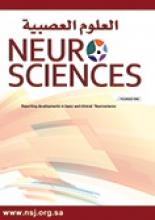Research ArticleOriginal Article
Open Access
Frequency of antiepileptic drugs and response change in pediatric patients receiving 2 or more antiepileptic drugs
Abla M. Albsoul-Younes, Amira T. Masri, Lobna F. Gharaibeh, Amer A. Murtaja and Abdelkarim A. Al-Qudah
Neurosciences Journal August 2020, 25 (4) 269-275; DOI: https://doi.org/10.17712/nsj.2020.4.20190113
Abla M. Albsoul-Younes
From the Department of Biopharmaceutics and Clinical Pharmacy (Albsoul-Younes, Gharaibeh, Murtaja), School of Pharmacy, Department of Pediatrics (Masri, Al-Qudah), School of Medicine, University of Jordan, Amman, Jordan
BSc, PhDAmira T. Masri
From the Department of Biopharmaceutics and Clinical Pharmacy (Albsoul-Younes, Gharaibeh, Murtaja), School of Pharmacy, Department of Pediatrics (Masri, Al-Qudah), School of Medicine, University of Jordan, Amman, Jordan
MD, PhDLobna F. Gharaibeh
From the Department of Biopharmaceutics and Clinical Pharmacy (Albsoul-Younes, Gharaibeh, Murtaja), School of Pharmacy, Department of Pediatrics (Masri, Al-Qudah), School of Medicine, University of Jordan, Amman, Jordan
BSc, MSc, PhDAmer A. Murtaja
From the Department of Biopharmaceutics and Clinical Pharmacy (Albsoul-Younes, Gharaibeh, Murtaja), School of Pharmacy, Department of Pediatrics (Masri, Al-Qudah), School of Medicine, University of Jordan, Amman, Jordan
BSc, MScAbdelkarim A. Al-Qudah
From the Department of Biopharmaceutics and Clinical Pharmacy (Albsoul-Younes, Gharaibeh, Murtaja), School of Pharmacy, Department of Pediatrics (Masri, Al-Qudah), School of Medicine, University of Jordan, Amman, Jordan
MD, ABCN
References
- ↵
- Bashiri FA
- ↵
- Naimo GD,
- Guarnaccia M,
- Sprovieri T,
- Ungaro C,
- Conforti FL,
- Andò S,
- et al.
- ↵
- Russo A,
- Posar A,
- Conti S,
- Parmeggiani A
- ↵
- Verrotti A,
- Tambucci R,
- Di Francesco L,
- Pavone P,
- Iapadre G,
- Altobelli E,
- et al.
- ↵
- Park KM,
- Kim SE,
- Lee BI
- ↵
- Joshi R,
- Tripathi M,
- Gupta P,
- Gulati S,
- Gupta YK
- ↵
- Martínez-Lizana E,
- Gil-Lopez F,
- Donaire A,
- Aparicio J,
- Brandt A,
- Carreño M
- ↵
- Nair DR
- ↵
- Plevin D,
- Jureidini J,
- Howell S,
- Smith N
- ↵
- Egunsola O,
- Choonara I,
- Sammons HM,
- Whitehouse WP
- ↵
- Albsoul-Younes A,
- Gharaibeh L,
- Murtaja AA,
- Masri A,
- Alabbadi I,
- Al-Qudah AA
- ↵
- Al-Qudah AA,
- Albsoul-Younes A,
- Masri AT,
- AbuRahmah SK,
- Alabadi IA,
- Nafi OA,
- et al.
- ↵
- Fisher RS,
- Cross JH,
- French JA,
- Higurashi N,
- Hirsch E,
- Jansen FE,
- et al.
- ↵
- Camfield PR,
- Camfield CS
- ↵
- Syvertsen M,
- Nakken KO,
- Edland A,
- Hansen G,
- Hellum MK,
- Koht J
- ↵
- Sirven JI,
- Noe K,
- Hoerth M,
- Drazkowski J
- ↵
- Lacy CF,
- Armstrong LL,
- Goldman MP,
- Lance LL
- ↵
- Moosa ANV
- ↵
- O’Rourke G,
- O’Brien JJ
- ↵
- Fishman J,
- Kalilani L,
- Song Y,
- Swallow E,
- Wild I
- ↵
- Gupte-Singh K,
- Wilson JP,
- Barner JC,
- Richards KM,
- Rascati KL,
- Hovinga C
In this issue
Frequency of antiepileptic drugs and response change in pediatric patients receiving 2 or more antiepileptic drugs
Abla M. Albsoul-Younes, Amira T. Masri, Lobna F. Gharaibeh, Amer A. Murtaja, Abdelkarim A. Al-Qudah
Neurosciences Journal Aug 2020, 25 (4) 269-275; DOI: 10.17712/nsj.2020.4.20190113
Jump to section
Related Articles
- No related articles found.
Cited By...
- No citing articles found.





